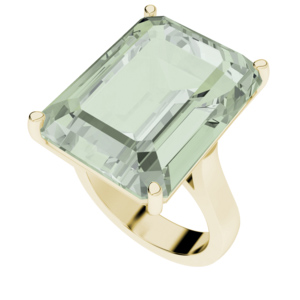We use semi-precious gems in our cocktail rings, pendants and earrings. In sourcing these stones, we’ve aimed for affordable, quality stones to ensure we have a gem for most colours – perfect for if you’re trying to match jewellery to an outfit for a special occasion. Alternatively, blue may be simply your favourite colour and you want your jewellery to reflect that!
For some of these colours/gemstones in these larger sizes, the natural version is eye-wateringly expensive; emeralds, rubies and sapphires fall into this category. We’ve been able to source man-made options as an alternative, so you can still have a beautiful blue cocktail ring for example. Where a gemstone is man-made, we’re explicit about the fact it is man-made. Man-made gemstones are called hydrothermal – referring to the process of creation through heat and water, or nano – referring to nanocrystal.
Our gemstones are provided by Australian companies, who source internationally. Sometimes, there may be delays in being able to source your stone - naturally-occurring gemstones are subject to supply and demand.
Here's some interesting gemstone information:
Gemstones
Blue topaz: is the state gemstone of Texas, USA
Amethyst (Brazilian): was used to ward off drunkenness in Roman times
Green amethyst: also known as mint quartz or prasiolite, the latter meaning ‘leek stone’ in Greek
Citrine: very rare in its untreated state, most citrine is actually a heat-treated version of amethyst
Onyx: also known as chalcedony agate, onyx is dyed to achieve its true black colour
Lemon quartz: A lighter, more lime version of citrine
Rose quartz: a translucent, slightly cloudy stone.
Morganite: a more unusual stone, but growing in popularity. This is named after the banker J.P. Morgan
Prehnite: much prehnite is mined in the Northern Territory of Australia
Tanzanite: Found only in the foothills of Mount Kilimanjaro
Iolite: with a history dating back to the Vikings, iolite only saw a rise in popularity in the 1980s when it started to be used more for jewellery
Amber: fossilized tree resin of an extinct species of pine tree that grew millions of years ago
Chrysoprase: this beautiful apple-green version of chalcedony comes from Queensland
Carnelian: Its reddish-brown colour is caused by iron oxide colouration.
Lapis lazuli: this is actually a rock, compared to most gemstones which are minerals
Turquoise: One of the most prestigious gemstones with a history going back over 3000 years
Peridot: this is the only gemstone that occurs in just one colour
Smoky quartz: traditionally used in Scottish jewellery, smoky quartz is also sometimes referred to as Cairngorm, a nod to its naming provenance of the Cairngorm mountains in Scotland
Tourmaline: can be green or pink. Pink tourmaline is sometimes referred to as rubellite
Aquamarine: its name is derived from Latin, meaning ‘sea water’
Ruby: the purest form of red seen in any gemstone
Emerald: one of the most rare gemstones to occur naturally on the planet
Blue sapphire: the word sapphire means blue in Greek
White sapphire: mostly mined in Sri Lanka
Yellow sapphire: Predominantly mined in Australia, and widely considered the best quality
Pink sapphire: Most highly regarded of the fancy coloured sapphires
Garnet (almandine): Found in abundance in Sri Lanka
Birthstones
There are a number of birthstone charts available but the most often used are the modern and the traditional ones. In order to offer birthstones in a range of colours and with round brilliant cuts, we’ve added one stone (Turquoise for June, instead of Pearl) from the traditional chart to the modern one.
January = Garnet
February = Amethyst
March = Aquamarine
April = Diamond
May = Emerald
June = Turquoise
July = Ruby
August = Peridot
September = Sapphire
October = Tourmaline
November = Citrine
December = Blue topaz
Pearls
Pearls are regarded as one of the five precious gemstones of old, together with ruby, sapphire, emerald and diamond.
Pink and black pearls may vary in their colour compared to the images shown; this occurs due to natural variation and/or the dyeing process.
Jewellery care
We’ve written a book on jewellery care which comes free with any StyleRocks purchase you make. Here’s a quick summary:
- Always store your jewellery carefully in a jewellery box away from sunlight
- Ensure you store it with type: pearls with pearls, gemstones with gemstones
- Avoid exposing your jewellery to makeup, perfume, chemicals, bleach, creams, lotions and potions
- Keep your jewellery away from baths, showers, pools and spas
- Treat your jewellery with care and avoid sharp blows
- Wipe your jewellery down with a soft cloth after wear
- Cleaning with a mild soapy solution and patting dry works for most item
- Ultrasonic cleaners are best for more durable items: gold, platinum, diamonds etc
- If in doubt, don’t use an ultrasonic cleaner
- Make sure you have your jewellery professionally cleaned on a regular basis
 +61 2 9969 4674
+61 2 9969 4674


